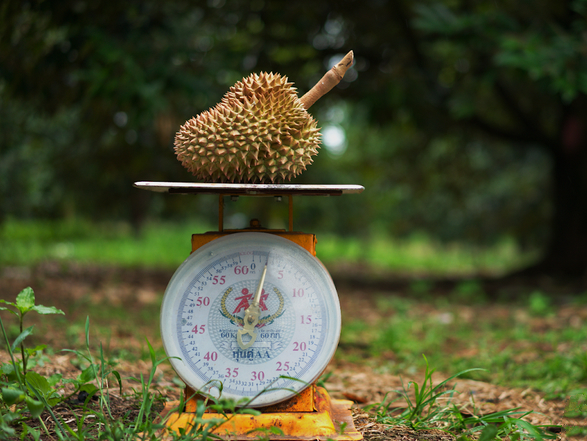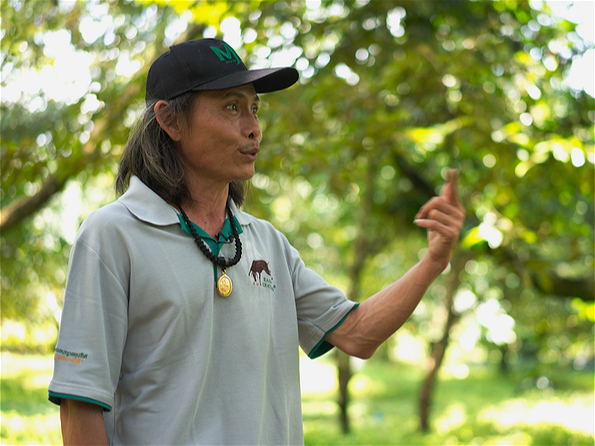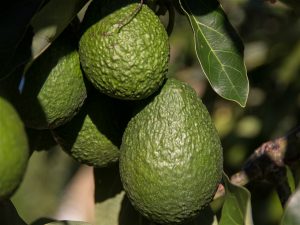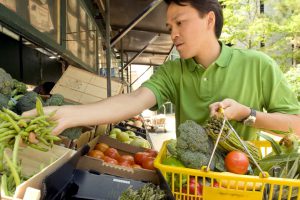Monthong means “golden pillow” in Thai, but to the farmers cultivating this creamy and sweet-tasting variety of the world’s most pungent fruit, Monthong durians simply mean gold.
China’s burgeoning middle class has taken a liking to what Southeast Asians call the King of Fruits, and their appetite is now being fed via rapidly evolving transportation infrastructure within the Mekong region that delivers it to Chinese markets to sell for up to US$60 a piece.
Last April alone the total value of Thai durian sales was recorded at US$220 million, an increase of 207% from the year prior. In a single minute, Alibaba Group’s Tmall.com sold 80,000 Monthong durians to Chinese consumers, and its rival JD.com moved 428,000 kilogrammes of the Thai delicacy in one day.
Chinese traders are increasingly prevalent in Thailand’s durian-producing east, where farmers are abandoning other crops to cash in on the durian bonanza. However, this dynamic is exposing huge risks fuelled by poor foresight in Thailand’s agricultural policy. This may put farmers deeper in debt and further weaken the country’s agricultural potential as it ebbs and flows with the Chinese market.
Monopoly money
Thailand has long been the world’s leading durian producer, with exports now rivalling domestic consumption by a factor of five to one. China receives up to 90% of Thai durian sent abroad. This has been aided by a unique agreement whereby Thailand is the only country authorised to import whole, fresh durian into Chinese markets.
As a result, Chinese entrepreneurs are penetrating more deeply into Thailand’s durian production process, using Thai nominees to drive purchase orders as well as set prices and harvest times.
“Last year, the durian price was set at 80 baht (US$2.50) per kilogramme, but it went up to 110 this year. They (China) took everything. We only have a little of what’s left from them,” says Tossapol Mangsachat, an owner of a durian roadside stall in Bangkok’s Yaowarat, or Chinatown, neighbourhood.

It’s the seller’s market when it comes to Monthong, the variety most sought after by Chinese consumers (Image: Jompol Daosokho)
Though this has been a boon for many small-scale farmers, China’s dominance over supply chains has made farmers nervous about the potential to fix prices and reduce incomes.
The rising prices are nonetheless causing many farmers to convert plantations of rambutan fruit and rubber to durian. The Department of Agricultural Extension reports that the number of durian orchards in Chanthaburi province has jumped considerably in the past year. The data also shows that most of the cultivated areas are Monthong varieties, which could lead to excessive supply over the next five years.
Piti Srisangnam, the director of academic affairs at the ASEAN Studies Centre, Chulalongkorn University, plays down concerns over a Chinese monopoly in Thailand’s agricultural sector, saying this is merely the way Chinese and other foreigners typically leverage new market opportunities in the country. Thailand itself should be looking deeper into how its agricultural sector could penetrate other markets located along the routes of the Belt and Road Initiative (BRI), he says.
“As long as it is about pushing more connectivity, that means China is our biggest export market and there is a way for us to be connected through roads, rails or even boats to this huge market,” Piti says.
But this connectivity works for other countries as well. Malaysia, which also cultivates durian just opposite its shared border with Thailand, hopes that next year China will be granting it clearance to import fresh durian too. Farmers there have already been planting new orchards in case such an agreement is forthcoming. Cambodia and Indonesia are also eyeing the market.
Monocropping monthong
Dr Songpol Somsri, the senior advisor at Thailand’s Department of Agriculture, says that durian has been cultivated for commercial purpose in Nonthaburi province for generations. Up until recently, there were hundreds of different species grown, offering a variety of flavours and textures. The native species can be divided into several areas: Kaan Yao from Thong Sook, Chanee from Luang, and Thong Yoi and Monthong from Kum Pun.
But only a few species are commercially grown, Kaan Yao, Chanee and Monthong among them.
Monthong is the variety most exported from Thailand to China, in part because under suitable conditions it can be kept for around 20 days after picking without spoiling.
According to the Department of Agricultural Extension, Monthong accounted for 89% of all the cultivated durian areas in Thailand, followed by Chanee with 7%. The remainder included Kra Dum, Kaan Yao and Puangmanee.
Farmers soon learn that Monthong is not easy to grow, taking up to eight years to bear fruit. It is quite vulnerable to diseases as compared to other native varieties such as Mongrak and Maneerak.
“Monthong is not that strong. Worms eat it, even though the trees are injected with chemicals every year in anticipation of these attacks. Worms like Monthong so much because it is creamy and its outer shell is not that hard. Other indigenous durian are stronger. They grow taller and we do not need to use pesticide to protect them from worms,” said one farmer.
Part of the problem says Kingkorn Narintarakul na Ayutthaya, deputy director of the BioThai Foundation, is that monocropping renders plants more prone to diseases and they are more easily destroyed by extreme weather conditions. “A single crop is very vulnerable, so chemicals, hormones and pesticide are used… At the same time, these chemicals tend to destroy the surrounding ecology,” Kingkorn observes.
She emphasises that cutting down trees to cultivate durians for commercial purposes harms plant genes, creates instability for farmers’ livelihoods and contributes to food insecurity over the long term.
“For example, the diverse fruit orchards in Nonthaburi province were bought and all the trees were cut down to cultivate Monthong durian. This has dramatically altered the soil composition. I do not think this practice is sustainable. Once people lose interest in Monthong or the fruit is found to grow better elsewhere, we’re stuck with a severely degraded agricultural ecosystem,” Kingkorn predicts.
In pursuit of diversity
Over the past few years consumers in Thailand and abroad have shown an interest in other durian species. This can be seen in supermarkets and online where the fruit can be purchased directly from farmers, says Kingkorn.
She is optimistic about greater domestic demand for different varieties. Cultivating a diversity of species is a significant element for sustainable agricultural development, making trees capable of surviving disease, climate change and better meeting the whims of consumer demand.
“This interest is not necessarily new, just untapped. People often wonder where all the native mangoes or durians have gone. The market took them away, and the market can bring them back, with all their different flavours and characteristics,” Kingkorn says.
Standing in his farm in Chanthaburi’s Klung district, Manop Amorn-aracha, a durian-orchard owner who grows both Monthong and other indigenous varieties says each species has its own distinctive feature.

In preparation for growing climate uncertainty, farmer Manop says there is an urgent need to conserve durian genetic diversity (Image: Nattaporn Taotagoo)
“For example, Chompu Sri has a good taste but is used to produce sweetened paste or syrup because it is very meaty,” says Manop.
He decided to cultivate a wider range of native durians to bring back what he remembered from childhood. His family used to grow Kum Pun Thong durian. When their land was reclaimed, he took a tendril to transplant. He does not want these species to go extinct.
“So many durian species are almost gone, except Monthong, Kradum and Kaan Yao. Even Chanee is very rare nowadays,” Manop says, adding that the rare durian varieties from his farms are directly sold to consumers for up to 350 baht (US$11) per kilogramme.
“I think there would be high demand for these other indigenous durians. People only eat Monthong because when they go to most markets in Thailand… It’s time to get some other varieties,” advises Manop.
A deeper problem
Thailand’s government could be far more proactive to ensure farmers maintain a comparative advantage in the country’s durian production, says Kingkorn. But so far it has remained fairly hands-off, other than to facilitate the current expansion of Monthong production.
Thailand’s producers of longan fruit know the scenario all too well. When Chinese dealers came to buy, prices initially increased but eventually fell as those dealers came to dominate the market.
Not many years ago, Kingkorn observes, Thailand was the leading exporter of rice, only to be overtaken by farmers in India and Vietnam.
Charoen Laothamatas, president of the Thai Rice Exporters Association, says Thailand’s “…failure to formulate long-term policies for the rice industry” is problematic and that the country should be pursuing a greater range of diversity in production. So, not surprisingly, 2019 export forecasts are being scaled back due to intense competition from other countries.
“All Thailand does is wait and see what others are doing and allows them to come here for the taking. We should be driving the market for rich, diverse, and healthy agricultural products, produced equitably and sustainably. We have all the ingredients and farmers are more than ready, there’s just no political will,” Kingkorn says.
The story was first published by Earth Journalism Network and this slightly edited version is republished here with permission.







![Women in Kapri village Bajura, western Nepal, preparing millet for use after harvest [Image by Nabin Baral]](https://dialogue.earth/content/uploads/2019/01/photos-for-story-two-1-300x200.jpg)
![Gagas valley in Uttarakhand, irrigated by the Gagas river [image by: Hridayesh Joshi]](https://dialogue.earth/content/uploads/2019/02/Springs1-300x172.jpg)